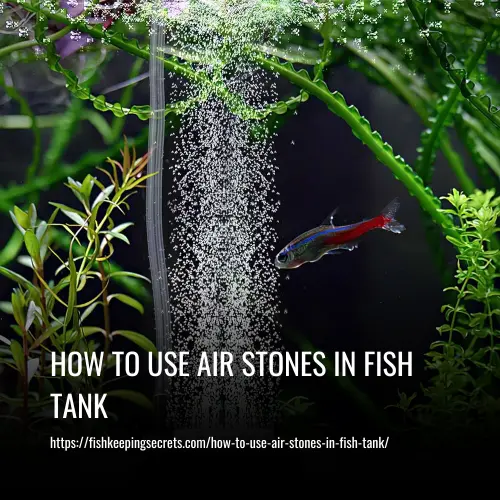Air stones are a popular and effective tool for maintaining a healthy aquarium environment for fish. They work by producing a stream of small bubbles that help to circulate and oxygenate the water in the tank. This not only creates a visually appealing display but also provides essential oxygen to the fish and other aquatic organisms.
To use air stones in fish tank, follow these steps:
- 1. Selection of Air Stones
- 2. Location of Air Stones
- 3. Frequency of Using Air Stones
- 4. Daily Maintenance of Air Stones

How To Use Air Stones In Fish Tank
When using air stones in aquariums, it’s important to consider the selection, location, frequency of use, and daily maintenance.
1. Selection of Air Stones
For the selection of air stones, choose small ones that create small bubbles to avoid causing stress or suffocation to the fish. Consider factors like dimension, power, and the size of your aquarium. A 2W nano airstone is a good option for small fish tanks as it creates constant bubbles and can be hidden under the water.
2. Location of Air Stones
When placing the air stone in the aquarium, it’s best to place it near the bottom and in stagnant water areas with less water circulation. Avoid burying the air stone under the substrate and keep it at least one foot away from the filtration system. Depending on the layout of your aquarium decoration, you can place the air stone in the corner or center.
3. Frequency of Using Air Stones
The frequency of using air stones varies depending on the oxygen needs of your tank. For tanks that require high oxygen levels, keep the air stone on for 24 hours. However, for tanks with fish and plants, it’s possible to turn off the air stone for a few hours a day. It’s recommended to keep the air stone on at night as plants release carbon dioxide during that time.
4. Daily Maintenance of Air Stones
Regular maintenance of air stones is necessary. You can clean them by soaking in a bleach solution for 2-3 hours, then rinsing and drying them. Alternatively, you can use clean fresh water, hydrogen peroxide, vinegar, cleaning tablets, or boil them for 10 minutes (excluding acrylic materials). Regular cleaning will help ensure optimal performance and prolong the lifespan of the air stones.
Why Should You Use An Air Stone In An Aquarium
Using an air stone in an aquarium has several benefits for the health and well-being of your fish. Here are some reasons why you should consider using an air stone:
1. Improved Oxygen Levels
An air stone helps to increase the oxygen content in the tank water. This is especially beneficial for fish that prefer to dwell at the bottom of the tank, as they may experience lower oxygen levels in that area. By promoting water circulation and producing oxygen-rich air bubbles, the air stone ensures that your fish have an adequate supply of oxygen.
2. Prevention of Toxic Waste Buildup
Poor water circulation can lead to the accumulation of toxic waste, such as ammonia and nitrites, in the tank. The air stone helps to prevent this buildup by keeping the water moving and allowing the filtration system to effectively remove these harmful substances. This helps to maintain a clean and healthy environment for your fish.
3. Reduction of Cloudy Water
The increased water movement caused by the air stone helps to prevent the water from becoming cloudy. It keeps the sediment from settling at the bottom of the tank, resulting in clearer and more visually appealing water.
4. Promotion of Physical Activity
Water circulation created by the air stone provides your fish with opportunities for exercise and physical activity. This is particularly important for active fish species that require plenty of swimming space. By improving water circulation and creating a bit of resistance, the air stone encourages your fish’s growth and muscle development.
5. Enhanced Filtration
By increasing oxygen levels and promoting water movement, the air stone improves the effectiveness of your tank’s biological filtration system. It helps to prevent waste buildup and maintains the chemical balance of the water. While the air stone can assist with filtration, it should not be relied upon as the sole means of maintaining the tank. Regular maintenance, including partial water changes, is still necessary for optimal tank stability.
6. Aesthetic and Ambiance
Air stones can add visual appeal and charm to your aquarium. The air bubbles produced by the air stone create a mesmerizing effect and can enhance the overall beauty of the tank. Additionally, air stones can help reduce noise generated by the aquarium, creating a more pleasant and relaxing atmosphere for both you and your fish.
7. Lower Maintenance Frequency
Incorporating air stones in the aquarium can reduce the frequency of maintenance tasks required. The increased water movement can help distribute and mix chemicals, reducing the need for manual stirring or dosing.
8. Noise Reduction
Air stones can help to minimize the noise produced by the filtration system. Placing the air stone at a distance of one foot from the filtration system can effectively reduce the noise levels, creating a more peaceful environment for both fish and their owners.
How Do You Keep Air Stone On The Bottom
There are several methods you can use to keep your air stone on the bottom of the tank. Adjusting the air pressure, unclogging the air stone, and using suction cups or rocks are all effective solutions.
1. Adjusting Air Pressure
If the water pressure is too high, it can cause the air stone to float. To prevent this, you can use a bleed valve to reduce the excess air pressure. This will maintain a moderate amount of air bubbles flowing from the air stone and keep it on the bottom.
2. Unclogging the Air Stone
Over time, debris, bacteria, algae, and calcium can accumulate on the pores of the air stone, reducing its effectiveness and causing it to float. You can unclog the air stone by using bleach and washing it every 5 to 6 weeks. This will remove any buildup and allow the bubbles to flow freely, keeping the air stone on the bottom.
3. Using Mini Suction Cups
Another effective method is to use mini suction cups to hold the air stone in place. Attach two suction cups to the tubing, one at the surface and the other at the bottom. The suction cups will hold the tube and keep the air stone stationary at the bottom of the tank.
4. Using Rocks
If suction cups or other methods are not available, you can use rocks or stones to hold the air stone down. However, this may not be as effective as suction cups and it can be challenging to find a rock that is heavy enough to keep the air stone at the bottom without restricting airflow.
By using these methods, you can ensure that your air stone stays on the bottom of the tank and functions properly to aerate the water.
How Long Do Air Stones Last
Air stones can last for a long time if they are not clogged. However, it is recommended to clean them at least every six months along with other aquarium equipment. There is no specific timeframe to replace an air stone, but they are affordable and easy to replace when needed. It is more likely that you will have to maintain your air pump before worrying about replacing the air stone.
How Much Is An Air Stone
The price of an air stone can vary depending on the type and brand. Generally, air stones are sold in packages of two or more and can be found for under $5. However, bubble bars or wands, which provide a different type of aeration effect, may be slightly more expensive and can cost up to $15. It’s always a good idea to shop around and compare prices before making a purchase.
FAQs
An air stone is a porous stone that releases small bubbles of air in the water. It’s used in a fish tank to improve water circulation, oxygenate the water, and promote healthy bacteria growth. It also helps to provide a more natural environment for the fish.
The best place to put an air stone in a fish tank is at the bottom, near the substrate. It’s better not to bury it too deep in the substrate. Look for areas with low water movement and still water, as this will help with circulation. By placing the air stone in these areas, you can increase oxygen levels and remove any debris that may be stuck in the lower parts of the tank.
It is not recommended to bury your air stone, especially if you have a sandy substrate. The bubbles can disturb the sand and lead to particles in the water. However, you can bury the air stone in gravel or place it underneath rocks for a more natural bubbling effect. Alternatively, you can hold the air stone at the bottom of the tank using stones or gravel without burying it. Just make sure to place rocks on the tubing to keep it in place.
To clean an air stone, start by washing it in clean water and using a brush to remove any debris. Let it dry for 15 minutes. Then, boil the air stone in water for 15 minutes and let it dry again. Next, create a solution with one part bleach and three parts water. Soak the air stone in the solution for 8 to 12 hours. After that, remove the air stone and connect it to an air pump in a bucket of clean water. Let it run for 10 minutes. Finally, remove the air stone from the pump and let it dry for 12 hours before placing it back in the tank.
Air stones are important in aquariums because they help create optimal gas exchange. In order for fish and plants to survive, there needs to be a balance between oxygen and carbon dioxide in the water. Air stones help agitate the water’s surface, allowing for the exchange of gases. This ensures that there is enough oxygen for the fish to breathe and removes excess carbon dioxide. Using air stones is a cost-effective way to maintain the necessary gas levels in the aquarium.
There are several benefits of using air stones in your aquarium. They help improve water circulation, ensuring that oxygenated water reaches all areas of the tank and preventing the buildup of harmful gases in dead spots. Air stones also create a soothing visual and auditory effect, with the steady stream of bubbles resembling waves on the ocean. Some fish may even enjoy swimming in and out of the bubbles, providing them with exercise.
Yes, it is highly recommended to use an air stone in your aquarium. Whether you have a filter or not, an air stone improves water circulation, keeps the water cleaner, and provides more oxygen for the fish. It also has numerous health benefits for the aquatic life. Additionally, air stones are inexpensive, so it won’t have a significant impact on your budget.
Fish can live without an air stone as long as there is enough aeration in the tank. This can be achieved through other means such as having live aquatic plants or using a water filter to keep the water moving. So, if you don’t have an air stone, there are alternative ways to provide oxygen for your fish.
Aquarium air stones work by circulating the water in the tank. When attached to an air pump outside the tank, the air stone produces small bubbles filled with oxygen. These bubbles then fill up the tank, providing oxygen to the water and helping to circulate it. As the bubbles rise to the surface, they lift the water near the substrate to the top, creating a continuous circulation process in the tank.
There are two main types of air stones: silica and aluminum oxide. Silica air stones are the most common and are available in various sizes. They are less expensive but not very durable. Aluminum oxide air stones are more durable and can withstand years of use and harsh cleaning. However, they are not recommended for use in glass aquariums because they can scratch the glass.
Yes, air stones can be beneficial for fish tanks in multiple ways. They help oxygenate the water, prevent the formation of harmful bacteria, maintain water quality, reduce maintenance frequency, and minimize noise from the filtration system. While not all aquariums require air stones, certain fish and plants with higher oxygen demands can greatly benefit from their presence.
An air stone serves multiple purposes in an aquarium. It helps oxygenate the water by diffusing air into tiny bubbles, improving the dissolved oxygen levels for the aquatic organisms. It can also be used as a part of the filtration system, promoting the growth of beneficial bacteria for maintaining water quality. Additionally, air stones can be used as a decorative element, creating visually appealing displays of bubbles in the aquarium.
It’s recommended to replace an air stone in your fish tank every 6 months to prevent them from becoming clogged and less effective. However, if you notice that the air stone isn’t working as well as it should, or that there are less bubbles, it’s better to replace it earlier.
Using an air stone in a fish tank is generally safe and beneficial for fish. However, excessive bubbling or too much water turbulence can stress out some fish species, especially bettas. To avoid this, it’s recommended to choose a small air stone or adjust the air pump to reduce the air flow rate.
Conclusion
In conclusion, air stones can be a valuable tool for improving the overall health and well-being of fish in a tank. By increasing oxygen levels and promoting water circulation, air stones can help prevent stagnant water and promote a healthy environment for fish to thrive. Additionally, air stones can also create a visually appealing display by producing a stream of bubbles and adding to the aesthetics of the tank.
When using air stones in a fish tank, it’s important to consider the size of the tank, the type of fish, and the overall goals for the aquarium. Proper placement and maintenance of the air stones are also crucial to ensuring they are effective in providing the necessary oxygenation and water circulation.



